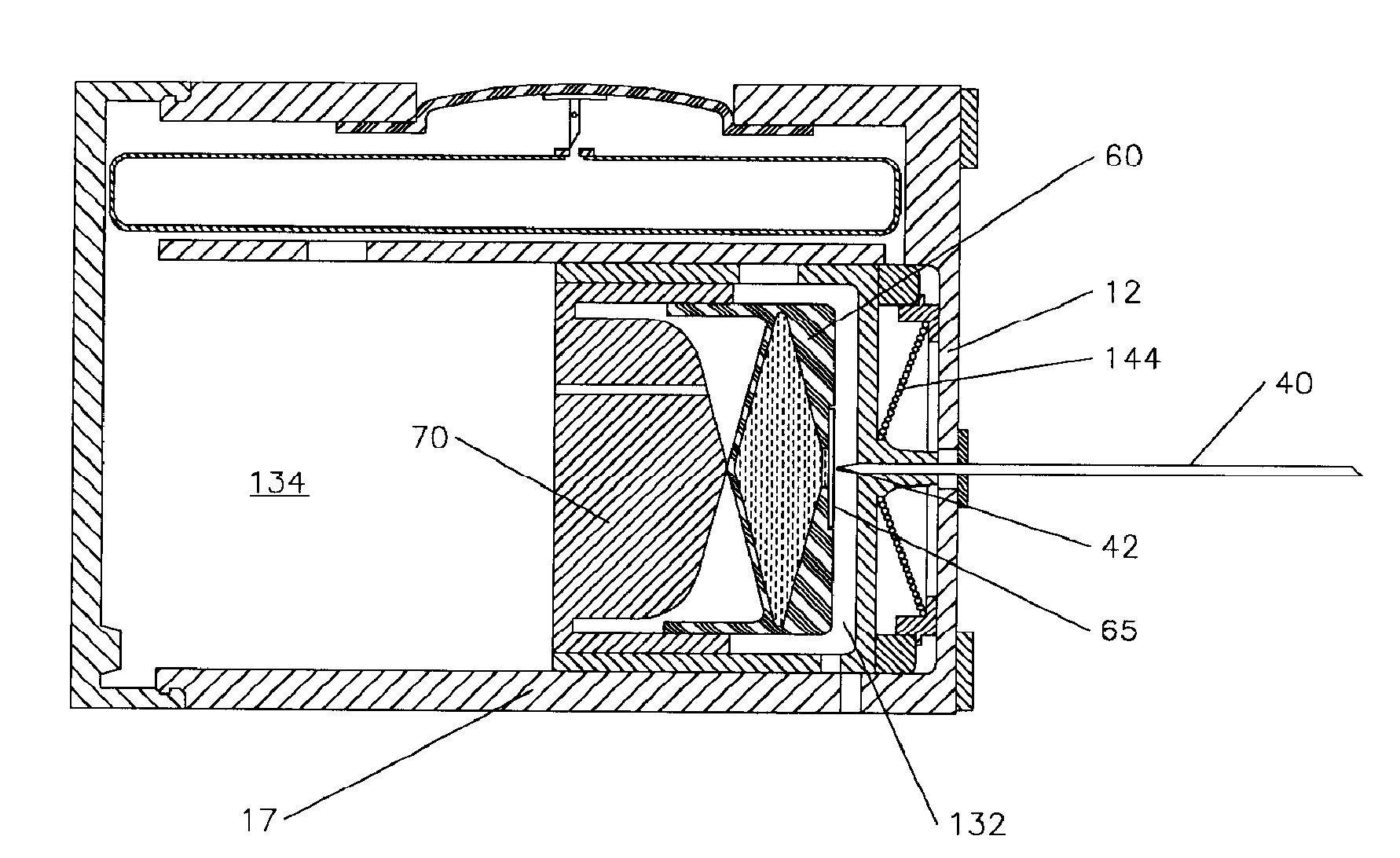Method and device for painless injection of medication
a medication and needle technology, applied in the field of injection of medication, can solve the problems of affecting the safety of patients, so as to achieve the effect of simple and inexpensive operation, high degree of safety for both medical personnel and patients
- Summary
- Abstract
- Description
- Claims
- Application Information
AI Technical Summary
Benefits of technology
Problems solved by technology
Method used
Image
Examples
first embodiment
[0073]A first embodiment, of the present invention provides a self-contained device for painless, inter-muscular injection of a liquid medicament, comprising a housing, an injection needle, a reservoir containing a liquid medicament, a means for liquid communication between the reservoir and the injection needle, a first means for inserting the injection needle, and a means for pumping the medication from the reservoir to an injection end of the needle.
[0074]More specifically, the first embodiment provides a self-contained device for painless, inter-muscular injection of a liquid medicament, comprising: a) a housing having a base for attachment to the skin of a patient, b) an injection needle disposed substantially perpendicular to the base and within the housing, the needle having an injection end, and configured for axial movement between a first position wherein the injection end is within the housing and a second position wherein the injection end extends outwardly from the base...
fourth embodiment
[0095]In another alternative embodiment, the needle inserting means, pumping means, and needle retracting means can individually or collectively comprise a pneumatic activating means. An embodiment of such a pneumatically driven device is later described in the
[0096]In an embodiment of the device of the present invention and illustrated in FIGS. 3a and 3b, a device can comprise a pair of medication flow valves 71 and 72 projecting laterally through the sidewall 17 of the device 1 and the sidewall 68 of the reservoir 60, respectively. The flow valves can be inserted into the sidewall 17 of the housing 10 and the sidewall 68 of a reservoir, such as in the device of FIG. 1b (though not shown). The flow valves 71 and 72 each comprise a self-closing, self-sealing passage, shown as a slit opening 73, through which a filling needle N can be inserted to inject medication M into the cavity 162 of the reservoir 60. In a typical embodiment, the medication flow valves 71,72 comprise an elastic,...
second embodiment
[0098]In the present invention, the invention provides a self-contained device for painless, inter-muscular injection of a liquid medicament, comprising a housing, an injection needle, a reservoir containing a liquid medicament, a means for liquid communication between the reservoir and the injection needle, a first means for inserting the injection needle, and a means for pumping the medication from the reservoir to an injection end of the needle.
[0099]More specifically, the second embodiment provides self-contained device for painless, inter-muscular injection of a liquid medicament, comprising: a) a housing having a base for attachment to the skin of a patient, b) an injection needle disposed substantially perpendicular to the base and within the housing, the needle having an outside diameter less than about 0.38 mm, an inlet end and an opposed injection end, and configured for axial movement between a first position wherein the injection end is within the housing and a second po...
PUM
 Login to View More
Login to View More Abstract
Description
Claims
Application Information
 Login to View More
Login to View More - R&D
- Intellectual Property
- Life Sciences
- Materials
- Tech Scout
- Unparalleled Data Quality
- Higher Quality Content
- 60% Fewer Hallucinations
Browse by: Latest US Patents, China's latest patents, Technical Efficacy Thesaurus, Application Domain, Technology Topic, Popular Technical Reports.
© 2025 PatSnap. All rights reserved.Legal|Privacy policy|Modern Slavery Act Transparency Statement|Sitemap|About US| Contact US: help@patsnap.com



